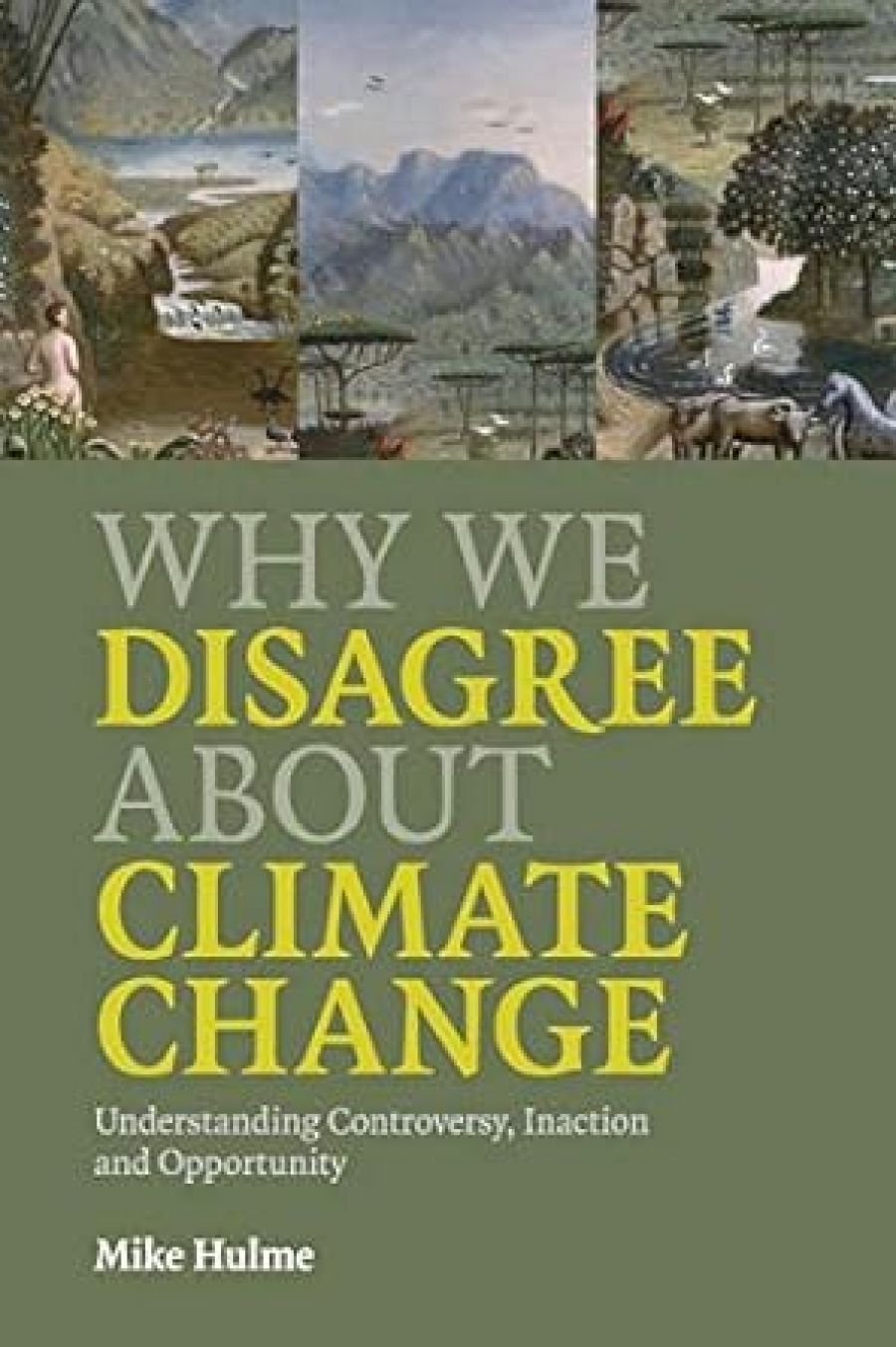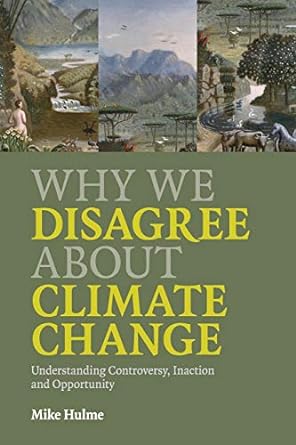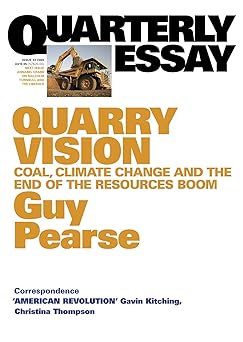
- Free Article: No
- Contents Category: Climate Change
- Review Article: Yes
- Article Title: Climatic quarrels
- Article Subtitle: The new social meteorology
- Online Only: No
- Custom Highlight Text:
Have you heard the latest joke about emissions trading? There was this factory in China that produced so much carbon dioxide from coal they had to get rid of it somehow. So they sold it to Coca-Cola. We shall burp away in the cause of carbon sequestration, imaginatively interpreted. Somewhere in the joke is a kernel of truth. If there’s a buck to be made from climate change, there’ll be someone, somewhere, who’ll be making it, and we’re right to be suspicious.
- Book 1 Title: Why We Disagree About Climate Change
- Book 1 Subtitle: Understanding controversy, inaction and opportunity
- Book 1 Biblio: Cambridge University Press, $39.95 pb, 431 pp
- Book 1 Cover Small (400 x 600):

- Book 2 Title: Quarry Vision
- Book 2 Subtitle: Coal, climate change and the end of the resources boom (Quarterly Essay 33)
- Book 2 Biblio: Black Inc., $16.95 pb, 129 pp
- Book 2 Cover Small (400 x 600):

Hulme starts with the meanings of climate change drawn from science, where what matters, as well as ‘the facts’, are our expectations of what science can and cannot do. For example, science shows the reality of climate change, but cannot say what is, and what is not, dangerous for people in different societies in different parts of the world. A further dimension is ‘the endowment of value’, which entails conflicting economic, social or ethical values. Climate change takes on new meanings for those seeking to extend economic values to embrace social justice and ethical decision-making. A chapter on ‘the things we fear’ looks at what happens when science inspires messages of eco-catastrophe, where we may relate to climate in terms of global disaster and terror. An important chapter on ‘the way we govern’ spells out issues in governing global climate, and why the various global agreements seem unreachable. Lastly, Hulme weaves these separate strands into a conclusion entitled ‘Beyond Climate Change’. Differences are always going to be with us; we need to learn to live with climate change more as a constant companion than as an ultimate threat. The idea of climate change becomes a tool for thinking about ‘what is the good life?’ We may yet learn to live within our climatic income, beyond the need to see climate change as punishment for climatic sins.
As a way of reading the multiple meanings of climate, I took The Age for a few days in late September and found the following issues raised. Barack Obama, in his first address to the United Nations, deplored the consequences of inaction, and argued in favour of cutting subsidies on fossil fuels. Penny Wong conducted negotiations on Australia’s proposed emission trading scheme; Malcolm Turnbull was critical. A harrowing story from the Bush Fires Royal Commission told of the death of two brothers as they tried to defend a house. Experienced firefighters, both were unprepared for the extreme nature of the 2009 fires. A red dust storm blanketed Sydney as, after eight years of drought and record temperatures, New South Wales experienced ten times more dust storms than usual. China planned for reforestation. Japan pledged to cut its carbon emissions by a quarter within eleven years.
The arts pages listed the best of the recent eco-disaster movies, from Flood (London underwater), Typhoon (China blown away), 252: Signal of Life (Tokyo subway flooded) and Haeundae (a giant tsunami hitting Korea). In the business section, BHP, in its own annual sustainability report, acknowledged that it is behind in attempting to meet its own 2012 targets for greenhouse gas, energy and water management. It seems that one of the worst power station polluters will get a $10 billion payout in compensation under a proposed carbon pollution reduction scheme. Climate change is a hot topic of general conversation.
Why We Disagree about Climate Change is a good title, and Hulme’s subtitle, Understanding Controversy, Inaction, and Opportunity, serves as a guide to the second book under review, Guy Pearse’s Quarry Vision: Coal, Climate Change and the End of the Resources Boom. ‘Quarry vision’ is the belief that mineral and energy resources are Australia’s great assets, coal especially. Pearse is an impassioned critic of inaction in the face of climate change. In his Quarterly Essay and his previous book High and Dry: John Howard, Climate Change and the Selling of Australia’s Future (2007), he tells how inaction was vigorously pursued in the Howard years and now, it seems, in the Rudd era. Forget the science of climate change: industry lobbyists, consultants and spin doctors prevail in advancing particular economic interests. As America is fueled by oil, so Australia is stoked by coal.
Pearse’s book can be read as an expansion of one of Hulme’s dominant interpretations of climate change: ‘climate change as justification of the commodification of the atmosphere and especially for the commodification of the gas carbon dioxide.’ In this ‘business as usual’ course of action, ownership rights to emit carbon dioxide are allocated and the market regulates and prices the commodity. Here, coal is of particular relevance. Pearse considers the resources boom in coal and calls for action to stop it, in light of scientific evidence of the harm coal does to the environment. In the face of evidence as compelling as the evidence that cigarettes and asbestos cause cancer, on both of which Australia has acted, why is it that coal is not yet seen as equally dangerous? Pearse is particularly critical of the notion of ‘clean coal’, where any cleansing technology is still to be developed. I read recently that the term ‘clean coal’ has been dropped in some electricity generating circles in favour of ‘Dual gas demonstration project’. The subheading in The Age of 26 September 2009 reads ‘Coal comes out green – after a good spin-wash’.
Pearse examines the economic orthodoxy impelling Australia to mine and export coal. In a television interview in 2008, Brendan Nelson stated that an emissions trading scheme would endanger primary industries because resources (mining, metals and energy) account for thirty-seven per cent of Australia’s economy. Nelson, says Pearse, overstated threefold the economic importance of these industries as a share of GDP, ‘but no one seemed to notice’. The argument is that Australia needs the money from mining and exporting coal to continue to thrive. Pearse disagrees. He contends that, if carbon pricing becomes a reality, ‘almost every Australian industry, including almost every quarry industry would continue growing and only more cleanly, and emerge far bigger in 2050 than today’. Pearse, in challenging Nelson on GDP, exposes the paradox such arguments face: both presume continued growth despite evidence of resource depletion.
We disagree about climate change in this instance because we value things differently. Nelson expressed the desire to maximise Australia’s economic well-being, interpreted in a particular way. Pearse argues the case for more than one path to maximising economic health. The notion of responsibility to future generations should include the call for an end to the reign of coal.
These books are good to read side by side. Both examine difficult issues in language accessible to the enquiring reader. Why We Disagree about Climate Change, as with many textbooks, provides useful summaries within each chapter, both at the end and in boxed inserts. No longer is it a good idea to cling to irrational exuberance in a personal theory of the weather. These two books are excellent guides to the new social meteorology.


Comments powered by CComment